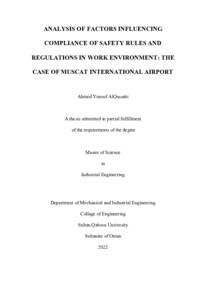وثيقة
Analysis of factors influencing compliance of safety rules and regulations in work environment : the case of Muscat International Airport.
عناوين أخرى
تحليل العوامل المؤثرة على التقيد بقوانين وقواعد السلامة في بيئة العمل : دراسة حالة في مطار مسقط الدولي
الناشر
Sultan Qaboos University.
ميلادي
2022
اللغة
الأنجليزية
الملخص الإنجليزي
The aim of the study is to identify, analyze and confirm the significance of factors affecting
safety compliance behavior in the airfield workers of Muscat International Airport. The airfield
is the part of airports dedicated to the movement of aircraft, landing, and take-off as well as
taxiing in and out of the terminal gates. The airfield is a heavily congested area with multi stakeholders working harmoniously at the same time to deliver safe and timely service for
passengers. Nonetheless, airfield accidents, if happened, can lead to fatalities or serious
injuries. For that, airports employ state-of-the-art safety management systems to ensure the
wellbeing of people. Practitioners reported that airfield safety violations, many times, are
contributed due to behavioral aspects rather than a management system. Therefore, the motive
of this study is to identify and analyze the behavioral factors that assist people working in the
airfield to better follow and comply with airport safety rules. To achieve the aim of this study,
a three-phase carefully designed methodology is proposed. The first phase is concerned with
conducting a Systematic Literature Review (SLR) to extract factors from publications
combined with an iterative process to cluster them. Thereafter, the data collection and statistical
analysis starts. Here, an online questionnaire is used to collect data from the case study while
employing a combined technique of Structural Equation Modeling (SEM) and Artificial Neural
Network (ANN) to identify the significance of factors and develop a prediction model aiming
to monitor the changes, respectively. Accordingly, the third phase a framework on how to
modify the safety policies.
The proposed conceptual framework was implemented at Muscat International Airport as a
case study. The SLR process puts on view a total of 33 sub-factors which are then grouped into
eight main factors that affect safety compliance. The analyses revealed that work environment
is the most influential factor on Safety Compliance. Further, SEM also confirmed the
significance of individual attributes on herd behavior, and off-work environment on worker's
motivation. The effect of work environment, knowledge and competency, and management
factors were deemed significant on the airport organizational culture. In the selected case study,
People and Culture, HSE and Airfield Operations are the airport's departments responsible for
change monitoring and implementation. It is proposed that together they may form a review
framework that utilizes the ANN perdition model. The role of each department in the proposed
framework is as follows. People and Culture department collects and analyze data periodically
from various stakeholders and composes results' report. Subsequently, HSE and Airfield
Operations departments plan and implement suitable safety initiatives to deal with the reported
safety concern. After the initiative implementation, feedback survey is sent to detect safety
compliance behavioral changes from airfield workers.
المجموعة
URL المصدر
قالب العنصر
الرسائل والأطروحات الجامعية

